Citation: Taylor, G. J. (May, 2012) Titanium Isotopes Provide Clues to Lunar Origin. Planetary Science Research Discoveries. http://www.psrd.hawaii.edu/May12/Ti-isotopes-EarthMoon.html (date accessed).
 |
May 30, 2012
Titanium Isotopes Provide Clues to Lunar Origin
--- The titanium isotopic mix is essentially identical in Earth and Moon, important new information with implications for the origin of the planets.
Written by G. Jeffrey Taylor
Hawai'i Institute of Geophysics and Planetology
The idea that the Moon formed as the result of the giant impact of a Mars-sized impactor with the still-growing Earth explains two central facts about the Earth-Moon system: its total angular momentum (Earth's spin and the Moon's orbital motion), and the sizes of the metallic cores of the Earth (large) and Moon (tiny). This gives cosmochemists some confidence in the hypothesis, but they would greatly appreciate additional compositional tests. One undisputed point is the identical abundance of the three oxygen isotopes in Earth and Moon. Junjun Zhang and colleagues at the University of Chicago (USA) and the University of Bern (Switzerland) have added another isotopic system to the cosmochemical testing tool kit, titanium isotopes. They find that the ratio of titanium-50 (50Ti) to titanium-47 (47Ti) is identical in Earth and Moon to within four parts per million. In contrast, other solar system materials, such as carbonaceous chondrites, vary by considerably more than this—up to 150 times as much.
The identical oxygen and titanium isotopic compositions in Earth and Moon are surprising in light of what we think we know about planet formation and formation of the Moon after a giant impact. The variations in oxygen and titanium isotopes among meteorite types suggest that it is unlikely that the Moon-forming giant impactor would have had the same isotopic composition as the Earth. Simulations show that the Moon ends up constructed mostly (40-75%) from the impactor materials. Thus, the Moon ought to have different isotopic composition than does Earth. The isotopes might have exchanged in the complicated, messy proto-lunar disk (as has been suggested for oxygen isotopes), making them the same. However, Zhang and colleagues suggest that this exchange is unlikely for a refractory element like titanium. Could the impact simulations be greatly overestimating the contributions from the impactor? Was the mixing of building-block materials throughout the inner solar system much less than thought so that the impactor and early Earth actually had the same isotopic compositions? Zhang and coauthors also draw attention to the possibility that the impactor could have been rich in ice, so that the Moon formed mostly from Earth's rocky materials. Questions abound as our understanding of planet formation evolves. Whatever the cause of the titanium-isotope homogeneity in the Earth-Moon system, the new data from titanium isotopes herald new directions for understanding the complicated processes involved in forming the Moon by a giant impact.
Reference:
- Zhang, J., Dauphas, N., Davis, A. M., Leya, I., and Fedkin, A. (2012) The Proto-Earth as a Significant Source of Lunar Material, Nature Geoscience, v. 5(4), p. 251-255, doi:10.1038/ngeo1429.
- PSRDpresents: Titanium Isotopes Provide Clues to Lunar Origin --Short Slide Summary (with accompanying notes).
The Giant Impact Hypothesis
 |
The giant impact hypothesis for the Moon's formation has now been around for over 35 years, ever since insightful papers in 1975 by Bill Hartmann and Don Davis, and in 1976 by Al Cameron and Bill Ward. The concept is widely considered in cosmochemical circles as the best idea so far, mostly because it answers two basic, global facts about the Earth and Moon. One fact is the Earth has a hefty metallic core, representing about 30% of its mass, whereas the Moon has a tiny core, no more than a few percent of its total mass. Computer simulations of the giant impact explain this by the core of the impactor accreting to the Earth's core while constructing the Moon from the non-metallic, silicate outer portions of both bodies. The hypothesis also explains the Earth's rotation and the Moon's orbital motion, features of the total angular momentum. Conventional theories for how planets grow by accreting planetesimals do not explain why the Earth rotates: for every incremental addition of a planetesimal that makes it spin in one direction, another addition makes it spin the other direction. However, one big impact near the end of accretion can add just the right amount of angular momentum.
Artist's conception of the giant impact that may have led to formation of the Moon. An impactor the size of Mars smashed into the proto-Earth, increasing the Earth's mass by about 10% (the final big increment in Earth's construction) and tossing material into orbit. Computer simulations suggest that at least 40% (possibly as much as 75%) of the material that ended up in orbit came from the impactor. The metallic core of the impactor was driven deep inside the Earth to become part of its core. Planetary scientists often call the hypothetical impactor "Theia," named for the mother of Selene, the Moon goddess of Greek mythology.
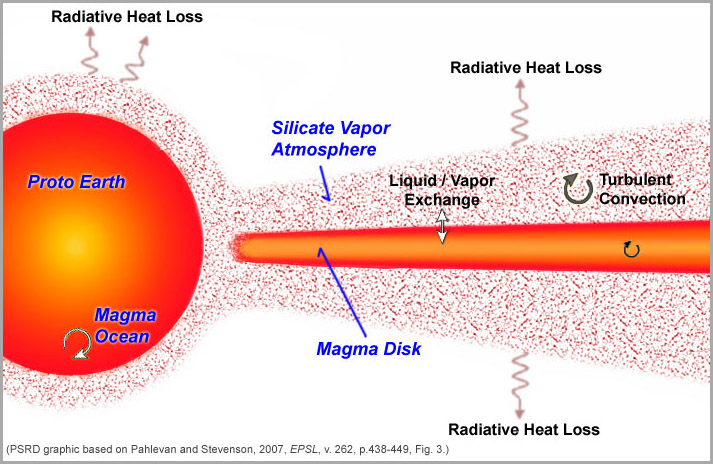 |
| The proto-Earth and the proto-lunar disk immediately after the giant impact, as depicted by Kaveh Pahlevan and Dave Stevenson. Rapid loss of heat into space causes convection in the Earth, the magma disk, and the silicate atmosphere, all of which might facilitate exchange of material to even out differences in isotopic and chemical compositions. The silicate atmosphere would act as the exchange medium between Earth and the proto-lunar disk. A key question is whether titanium isotopes could equilibrate between the disk and Earth as readily as oxygen apparently did. The magma disk is drawn much thicker in relation to the scale of the drawing than it would have been in reality. Only about two lunar masses end up in the disk, which translates to a thickness of a few tens of kilometers, only about 2% of the thickness we show in this diagram. In addition, the disk was probably not a uniform molten mass, but may have been patchier and consisted of orbiting blobs of magma with chilled, solid surfaces, intermingled with molten material. |
The giant impact resulted in a disk of molten and vaporized rock surrounding the essentially totally-molten Earth. An atmosphere connected the two objects, although gravitational tidal forces sheared off the melt near the Earth. The Moon formed from the orbiting disk. Some simulations have lunar formation happening in less than a year after the giant impact, but most depict the process occurring over a period of 100 to 1000 years. The disk was not a nice uniform, molten, flat cylinder. It probably involved formation of clumps whose interactions caused the disk to heat and spread out.
The angular momentum of the Earth-Moon system and the small metallic core inside the Moon are strong evidence for the giant impact hypothesis, but it would be good to have additional tests of the idea. We have known for a long time that the mixture of oxygen isotopes is the same in the Earth and Moon (see diagram below). Junjun Zhang and her colleagues report new, highly accurate data on titanium isotopes to add to the cosmochemical testing kit.
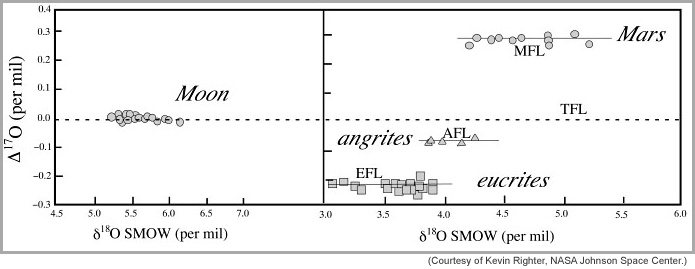 |
| Precise oxygen isotope data for Earth (dashed line), Moon, Mars, asteroid 4 Vesta (eucrite meteorites), and the igneous angrite meteorites. This diagram plots Δ 17O versus δ 18O, a diagram that isotope experts are particularly fond of. The δ 18O is simply the ratio of 18O to 16O, but normalized to the Earth value as represented by standard mean ocean water (SMOW). The data for each body spreads out along the x-axis because of chemical processing, but all lie close to a line with distinctive big delta O-17, a good parameter for comparing oxygen isotopic compositions. These data show that oxygen isotopic compositions vary throughout the solar system. TFL, MFL, AFL, and EFL stand for terrestrial, Mars, angrite, and eucrites fractionation lines, which is simply the way the isotopes vary with melting and crystallization. Note that all the points for the Moon fall on the terrestrial fractionation line. See PSRD article: Compositional Balancing before Moon Formation for more details about the diagram. |
Titanium Isotopes in the Moon, Earth, and Asteroids
Junjun Zhang, Nicolas Dauphas, and coworkers at the Origins Laboratory, Department of Geophysical Sciences and Enrico Fermi Institute, University of Chicago, have developed the chemical techniques and have the instrumentation to improve the precision of measurements of titanium isotopes in rocks. Zhang dissolved powdered samples weighing between 1 and 10 milligrams in sequential mixtures of acids and oxidizing chemicals, and then separated the titanium using assorted resins and acids that only a chemist can do. She measured titanium isotopes with masses 46, 47, 48, 49, and 50 in a multi-collector inductively coupled plasma mass spectrometer. This impressively named device, abbreviated MC-ICP-MS, produces a high-temperature plasma (a cloud of ions) which is fed into a mass spectrometer for isotope measurements. In a multi-collector system several isotopes can be measured simultaneously, improving precision. The isotope data were standardized using a natural terrestrial rutile (TiO2) sample.
Zhang measured the titanium isotopes in samples from the Earth, Moon, igneous meteorites, and chondrites (specifically enstatite, ordinary, and carbonaceous chondrites). The data are shown in the diagram below, expressed in the ratio of 50Ti / 47Ti in the sample to 50Ti / 47Ti in the rutile, in parts per ten thousand, minus 1. This parameter is named epsilon50Ti and expressed as ε50Ti. It shows differences compared to the standard in parts per ten thousand. Samples with identical 50Ti / 47Ti to the rutile have an epsilon (ε) value of 0. The diagram shows two important features [1] Earth and Moon have essentially the same 50Ti / 47Ti, and [2] the value varies considerably in other types of samples. Carbonaceous chondrites represent outer asteroid belt, possible even outer solar system, values.
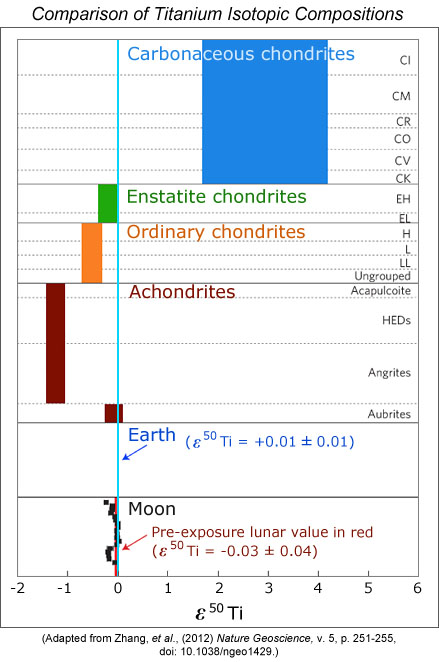 |
| Epsilon 50Ti values [ 50Ti / 47Ti in samples divided by 50Ti / 47Ti in a standard, expressed in parts per ten thousand, minus 1 ] for Earth, Moon, and assorted meteorite groups. Moon (red line) and Earth (blue line) values are identical to within 0.04 ε units, or only 4 parts per million. The other materials range left and right of the Earth-Moon value; see the color bars, individual data points for the terrestrial and chondrite samples are not shown. In reality, the lunar points tend to be slightly lower than the terrestrial value, but that is caused by changes in the titanium isotopes due to long exposure to cosmic rays while the samples were sitting near the lunar surface, patiently waiting for astronauts to collect them. Some resided within a few meters of the surface for hundreds of millions of years. Zhang was able to correct for these cosmic ray effects and the narrow band for the Moon (shown in red) represents the ε50Ti value for lunar samples before they were exposed to cosmic rays on the lunar surface. |
A complication in the lunar data arose because lunar samples reside near the surface for up to hundreds of millions of years. Because cosmic rays (composed mostly of high-energy protons) can alter the isotopes of titanium and other elements, Zhang and colleagues had to correct for this effect. Meteorites are affected by this, too, but their exposure times are much shorter, so the effect is not significant. To correct for cosmic-ray exposure of the lunar samples, Zhang plotted measured ε50Ti against ratios of samarium (Sm) and gadolinium (Gd) isotopes, using published data. These rare earth elements are particularly prone to capturing neutrons (which are produced by cosmic ray interactions with rock), so are useful monitors of the effects of cosmic-ray produced neutrons. Zhang and colleagues found reasonably linear correlations (see diagram below for samarium correlation). Their work yielded ε50Ti values for the lunar samples corrected for cosmic-ray exposure of -0.03±0.04 (for Sm) and -0.05±0.06 (for Gd). The average value for the Earth samples (no cosmic ray corrections needed) is +0.01±0.01. Thus, Earth and Moon have the same ε50Ti values within 0.04 ε units. The meteorites, on the other hand, spread over 6 ε units—a span 150 times larger.
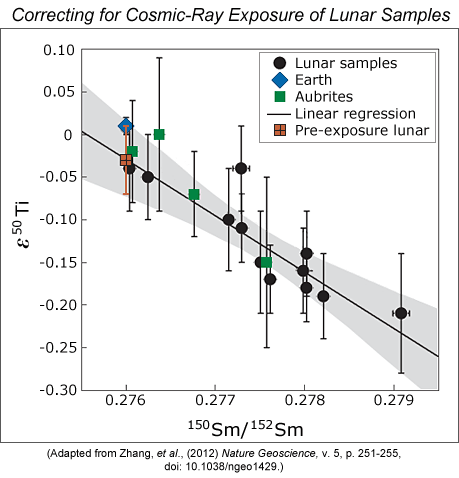 |
| Epsilon 50Ti values for lunar, Earth, and aubrite meteorite samples plotted against cosmic-ray sensitive isotopes of samarium (Sm). The black line is the best linear fit for lunar samples with 95% confidence envelopes shown in grey. The pre-exposure, corrected lunar value is -0.03±0.04 (red square). The terrestrial 50Ti value is +0.01±0.01 (blue diamond). Thus, the lunar samples have the same value as terrestrial samples within 0.04 ε units, 150 times less than the spread in ε50Ti values shown by meteorite samples. |
Titanium Isotopes and the Giant Impact
Cosmochemists do not agree about everything concerning the compositions of the Earth and Moon. Two particularly controversial issues are [1] the abundances of refractory elements (see PSRD article: Two Views of the Moon's Composition) and [2] the amount of oxidized iron (FeO) in the Moon compared to Earth. Thus, the new data are welcomed. We now know that both titanium and oxygen isotopes are the same in Earth and Moon. What does this tell us about the giant impact hypothesis and the ways planets form?
Isotopic compositions of oxygen and titanium vary throughout the solar system, as discussed above. Model calculations of planetary accretion indicate considerable lateral mixing of planetesimals formed in different regions of the solar nebula. They also show that the mixing is somewhat random in that the final, large planets that form in the simulation-models vary in chemical composition (see diagrams below). Thus, if the calculations are realistic, Theia and the proto-Earth ought to have differed in isotopic composition.
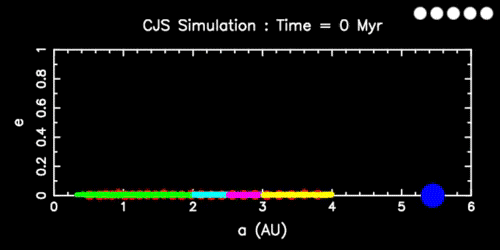
|
| (Courtesy of David P. O'Brien, Planetary Science Institute, Tucson, Arizona.) |
| Computer simulation (to 250 million years) of the accretion of the inner planets, assuming that Jupiter and Saturn exist and are in circular orbits. The x-axis is semimajor axis (AU ) and the y-axis is eccentricity. In this simulation, half the mass is in large bodies with masses equal to 10% of Earth's current mass; planetary dynamics experts call these planetary embryos. The other half is in bodies 1/40 as massive. Note the significant mixing of planetesimals (sideways motions). Movie from David P. O'Brien, Planetary Science Institute, Tucson, Arizona. |
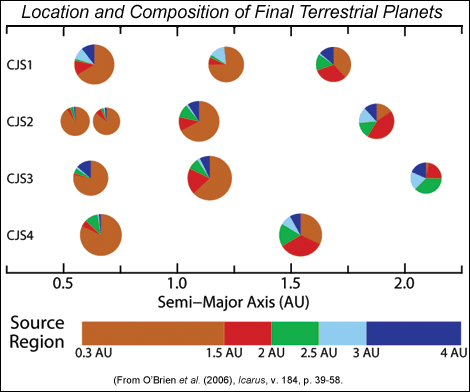
|
| The pie diagrams show the percentage of material from different initial regions of the solar nebula that end up in three or four "terrestrial planets" for four different simulations, labeled CJS1, CJS2, CJS3, and CJS4. The simulations suggest that objects the size of Earth and Theia are not likely to have the same compositions. |
Since models of the giant impact suggest that the Moon formed from a mixture of roughly equal amounts of Earth and Theia, and accretion simulations suggest that those two objects ought to have differed in composition, then why are the oxygen and titanium isotopic compositions in Earth and Moon so similar? Kaveh Pahlevan and Dave Stevenson suggest that oxygen isotopes equilibrated between the proto-lunar disk and Earth during the 100-1000 years it took to form the Moon (see PSRD article: Compositional Balancing before Moon Formation). Junjun Zhang and her colleagues investigated whether titanium could also have exchanged between the proto-lunar disk and Earth, resulting in the same Ti isotopic composition in each body. An important difference, however, between titanium and oxygen is that titanium is more refractory, so it would have lingered in the orbiting magma rather than been exchanged through the atmosphere. Their calculation suggests that the refractory element isotopes would have equilibrated in about 30 years, possibly enough time if the disk lasted long enough. The likely way significant exchange would have happened is if the orbiting magma was highly turbulent and substantially mixed. Zhang and colleagues point out that this concept needs more quantitative study.
An alternative explanation is that the planetary-accretion calculations overestimate the apparent variations in mixing of the building-block materials. Perhaps large objects in the inner solar system did not vary much in composition after accretion because numerous planetesimals were averaged together, muting chemical differences that existed throughout the inner solar system.
Another alternative is that the simulations of the giant impact completely misjudge the amount of the impactor that ends up in the Moon. Maybe the Earth provides almost all the material. The models seem to be quite robust, however, and it is unlikely that only tiny amounts of the impactor end up in the Moon, considering that much of the molten and vaporized rock that is blasted into orbit comes from the interface between Theia and the proto-Earth. Zhang and her colleagues raise the possibility that Theia was an icy intruder from the outer solar system that did not add much rock (hence very little titanium), but delivered lots of water-rich vapor that might have facilitated the exchange of oxygen isotopes. Interesting possibilities abound.
Importantly, the data reported by Zhang and coauthors do not disprove the giant impact hypothesis. Those old crucial pieces of the puzzle—angular momentum of the Earth-Moon system and the small lunar metallic core—are still there. Instead, these high-quality measurements of the similarity of titanium isotopes in Earth and Moon give cosmochemists an additional tool for probing the complicated process of lunar formation by a giant impact.
- PSRDpresents: Titanium Isotopes Provide Clues to Lunar Origin --Short Slide Summary (with accompanying notes).
- Cameron, A. G. W. and Ward, W. R. (1976) The Origin of the Moon. Lunar and Planetary Science Conference VII, p. 120-122. [NASA ADS link]
- Hartmann, W. K. and Davis, D. R. (1975) Satellite-Sized Planetesimals and Lunar Origin. Icarus, v. 24, p. 504-514. [NASA ADS link]
- O'Brien, D. P., Morbidelli, A., and Levison, H. F. (2006) Terrestrial Planet Formation with Strong Dynamical Friction. Icarus, v. 184, p. 39-58. doi:10.1016/j.icarus.2009.04.005. [NASA ADS link]
- Pahlevan, K., and Stevenson, D. J. (2007) Equilibration in the Aftermath of the Lunar-Forming Giant Impact. Earth and Planetary Science Letters, v. 262, p. 438-449. [NASA ADS link]
- Taylor, G. J. (2008) Compositional Balancing Before Moon Formation. Planetary Science Research Discoveries, http://www.psrd.hawaii.edu/Feb08/EarthMoonFormation.html.
- Taylor, G. J. (2007) Two Views of the Moon's Composition. Planetary Science Research Discoveries, http://www.psrd.hawaii.edu/April07/Moon2Views.html.
- Zhang, J., Dauphas, N., Davis, A. M., Leya, I., and Fedkin, A. (2012) The Proto-Earth as a Significant Source of Lunar Material. Nature Geoscience, v. 5(4), p. 251-255, doi:10.1038/ngeo1429. [article]
|
|
[ About PSRD | Archive | CosmoSparks | Search | Subscribe ] [ Glossary | General Resources | Comments | Top of page ] |
